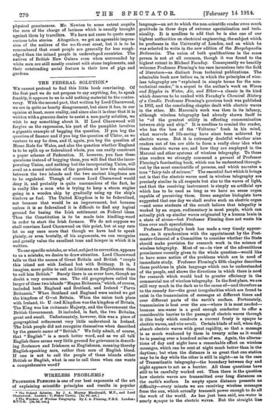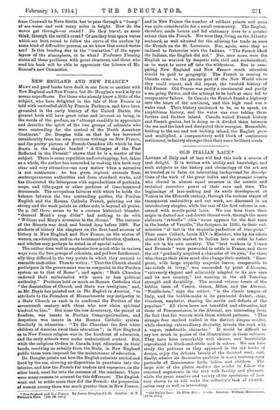WIRELESS PROBLEMS.t
PROFESSOR FLIMING is one of our best exponents of the art of explaining scientific principles and results in popular
• Th. Palatal. Sohdion. By J. A. Murray Macdonald, M.P.. and Lord Charnnood. London, T.-Ptahor Malvin. [Ea. Bd. nat.]
_ t The Wondara Wonteas Tdedropay. /37 J. A. Fleming, P.R.S. London s 8,r.C.E. LUG& natal language—an art to which the non-scientific reader owes much gratitude in these days of extreme specialization and tech. ideality. It is needless to add that he is also one of our highest authorities on electrical engineering, the subject which he professes in the University of London, and on which he was selected to write in the new edition of the Encyclopaedia Britannica. The union of both qualifications in the same person is not at all common, though it was found to the highest extent in Michael Faraday. Consequently we heartily welcome Professor Fleming's too rare incursions into the field of literature—as distinct from technical publications. The admirable book now before us, in which the principles of wire- less telegraphy are "explained in simple terms for the non. technical reader," is a sequel to the author's work on Wares and Ripples in Water, Air, and Ether—a classic in its kind which deserves to be ranked with Faraday's Chemical History of a Candle. Professor Fleming's previous book was published in 1902, and the concluding chapter dealt with electric waves in the ether. Mr. Marconi's work was then in its infancy, although wireless telegraphy bad already shown itself to be "of the greatest utility in effecting communication between ship and ship." It is needless to remind the reader, who has the loss of the ' Volturno' fresh in his mind, what marvels of life-saving have since been achieved by electric waves. But it is extremely doubtful whether nine readers out of ten are able to form a really clear idea what these electric waves are, and bow they are employed in the Marconi and other systems of wireless telegraphy. To those nine readers we strongly commend a perusal of Professor Fleming's fascinating book, which can be understood through. out by the most unscientific of persons, and which narrates a true "fairy-tale of science." The essential fact which it brings out is that the electric waves used in wireless telegraphy are precisely similar in all respects but size to the waves of light, and that the receiving instrument is simply an artificial eye which has to be used as long as we have no sense organ capable of perceiving them. Some sanguine biologists have suggested that one day we shall evolve such an electric organ —and some students of the occult believe that telepathy is worked by an organ, rudimentary in most people, which can actually pick up similar waves originated by a human brain in a state of stress—but Professor Fleming does not waste his time over such speculations.
Professor Fleming's book has made a very timely appear- ance, as it synchronizes with the appointment by the Post- master-General of a Committee to consider whether the State should make provision for research work in the science of wireless telegraphy. Most of us—in view of the adventitious prominence recently given to the whole question—would like to have some notion of the problems which are in need of immediate study. Professor Fleming's fifth chapter describes these problems in plain language which can be understanded of the people, and shows the directions in which there is need for research which would lead to greater efficiency in the commercial use of wireless telegraphy. In the firstplace, we are still very much in the dark as to the cause of—and therefore as to the remedy for—the great irregularities which are found to exist in the transmission of messages at different times and over different parts of the earth's surface. Fortunately, transmission is best over the sea—where it is most needed— because sea-water is a good enough conductor to offer a considerable barrier to the passage of electric waves through it (the body which conducts a current freely is opaque to electric waves, and vice verse* Certain kinds of soil, when dry, absorb electric waves with great rapidity, so that a message is as much weakened by them in twenty miles as it would be in passing over a hundred miles of sea. Again, the alterna- tions of day and night have a remarkable effect on wireless messages, which can be sent at night much better than in the daytime; but when the distance is so great that one station may be in day while the other is still in night—u in the case of Transatlantic telegraphy—the boundary between day and night appears to act as a barrier. All these questions have still to be carefully worked out. Then there is the question how electric waves are transmitted over long distances on the earth's surface. In empty apace distance presents no difficulty—every minute we are receiving wireless messages from the sun, which actually transmit power enough to do all the work of the world. As has just been said, sea-water is nearly opaque to the electric waves. But the straight line from Cornwall to Nova Scotia has to pass through a "hump" of sea-water and rook many miles in height, How do the waves get through--or round ? Do they travel, as some think, through the earth's cruet Or are they true space waves which are bent round to follow the curve of the surface by some kind of diffractive process, as we know that sound waves are? Is this bending due to the "ionization" of the upper layers of the atmosphere, or to what ? Professor Fleming states all these problems with great clearness, and those who read his book will be able to appreciate the labours of Mr. Samuel's new Committee.







































 Previous page
Previous page